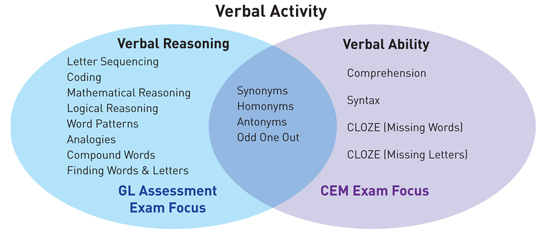Why have we changed the name of our series from Verbal Reasoning to Verbal Activity?

CEM terminology has been rather confusing for parents because they have introduced a new category of testing known as ‘verbal ability’. Is this traditional verbal reasoning or something else? It is in fact a combination of some elements of the vocabulary and spelling aspects of traditional style verbal reasoning combined with the testing of English skills.
Verbal ability covers synonyms, antonyms, homonyms, odd one out, Cloze activity (choosing or completing the correct word to fit in a space), syntax (ordering words in sentences) and comprehension.
Verbal Reasoning covers coding, alphabet sequencing, number sequencing, number links, substitution, word patterns, word links and secret codes. (It also includes synonyms, antonyms, homonyms, odd one out and simple spelling questions.)
Hence there is some common ground between the two types of testing i.e. synonyms, antonyms, homonyms and odd one out questions.
AE Tuition’s sister company, AE Publications has decided to combine the verbal reasoning and verbal ability under one umbrella of VERBAL ACTIVITY. This means our books will prepare children for both types of examination (GL Assessment and CEM).
One of the fundamental objectives of AEP is to provide the best set of ‘how-to’ books on Maths, English, Verbal Activity and Non-verbal Reasoning available on the market. To this end, we endeavour to develop books that give children a foundation that not only covers every possible element of these subjects that could be examined in any current or future exams but, more than that, gives them the skills and knowledge on the subject that can be built on in future educational institutions.

